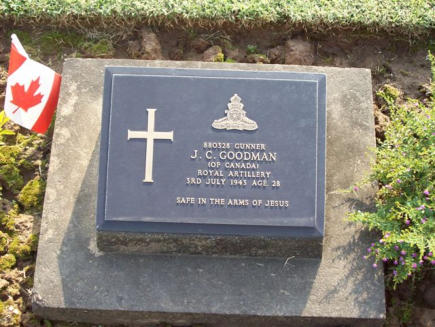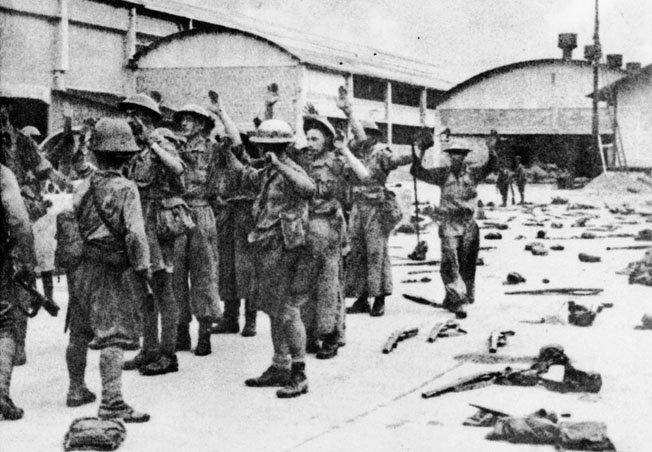
copyright © Wartime Heritage Association
Website hosting courtesy of Register.com - a web.com company
Wartime Heritage
ASSOCIATION
Remembering World War II


Name:
Rank:
Service No:
Service:
Date of Death:
Age at Death:
Cemetery:
Reference:
John Claydon Goodman
John (Jack) Claydon Goodman
Gunner
880328
British Royal Artillery, 9th Coast Regiment
July 3, 1943
28
Kanchanaburi War Cemetery, Thailand
6. A. 40.
Commemorated on page 164 of the Second World War Book of Remembrance
Displayed in the Memorial Chamber of the Peace Tower in Ottawa on April 5
Gunner John Claydon Goodman was the son of William H. Goodman (b. 1880) and Fannie
Goodman (b. 1889), of Ferguson's Cove, Halifax Co., NS. He was the brother of William (1910-1969),
Charles, Sydney, and Florence. His parents were from Birmingham, England, arriving in Nova Scotia in
1905. During WWI his father served with the Royal Canadian Garrison Artillery having served
previously for some eleven years and eight years with the Royal Garrison Artillery. In 1921 his father
was serving as a Gunner with the Royal Canadian Garrison Artillery.
During WWII, Gunner John (Jack) Goodman served with the British Royal Artillery, 9th Coast
Regiment.
On the outbreak of War in September 1939 the Singapore defences included the 9th Heavy
Regiment Royal Artillery. In the summer of 1940 Coast Units had their title changed from Heavy
Regiments to Coast Regiments. In February 1942, the Singapore Fixed Defences included the 9th Coast
Regiment Royal Artillery. On February 12, 1942 the Coastal Batteries were destroyed and on February
13, 1942 the garrison was marched to the Indian Recreation Ground in Singapore where it was formed
into an Infantry Battalion and used as support troops.
Singapore fell to the Japanese Army on February 15 and numerous British and Australian soldiers
were taken prisoner and many died in captivity. While some remained in Singapore's Changi Prison
others were shipped out on prisoner transports to other parts of Asia, including Japan, to be used as
forced labour on projects such as the Siam–Burma Death Railway and Sandakan airfield in North
Borneo.
Gunner Goodman was transported to work on the Siam–Burma Railway where he died in captivity.
He is buried in the Kanchanaburi War Cemetery, Thailand where 6,982 Allied Prisoners of War are
buried, having perished during the construction of the “death railway”.


British Soldiers surrender to the Japanese in Singapore,
February 1942



- World War I - Menu
- WWI Stories and Articles
- Photos - Yarmouth Soldiers
- Selection of World War I Songs
- WWI Casualties of Yarmouth, NS
- Those Who Served - Yarmouth, NS
- WWI Casualties Digby Co. NS
- WWI Casualties Shelburne Co. NS
- Merchant Mariners (1915) Yarmouth, NS
- Canadian Forestry Corps - Non Yarmouth Birth/Residence Enlistments
- US Draft Registry - Yarmouth NS Born


- World War II - Menu
- WWII Stories and Articles
- Telegraphist Air Gunners
- WWII Casualties of Nova Scotia
- US Casualties with NS Connection
- Far East/Pacific Casualties with NS Connection
- Merchant Navy Casualties Nova Scotia
- Nova Scotia WWII Casualties Holten Canadian War Cemetery
- D-Day Casualties - Nova Scotia
- CANLOAN Program Casualties - Nova Scotia
- Battle of the Bulge Casualties - Nova Scotia
- WWII Casualties Yarmouth NS
- Yarmouth Casualties - RCAF RAF Canadian Army WWII
- Yarmouth Co., Marriages WWII
- Casualties Non-Born/Residents with Connection to Yarmouth Co., Nova Scotia.
- WWII Casualties Digby Co., NS
- Non-Nova Scotian WWII Casualties Buried in Nova Scotia
- WWII RCAF Casualties Aged 16-18
- Brothers/Sisters Who Served - World War II














